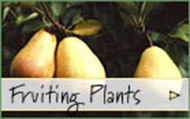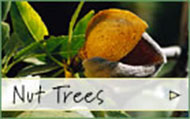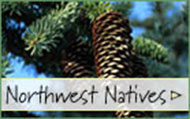NSOABUR
|
|
 |
| BUR OAK (Quercus macrocarpa) |
| This species has the largest leaves and acorns of any oak. Bur Oak nuts have been used as human food. Widely adapted. Good red fall color. Zone 3-9. |
|
|
NSOAEAS
|
|
 |
| EASTERN WHITE OAK (Quercus alba) |
| Large majestic tree, reliable producer of edible acorns. Widely adapted, good fall color. Eastern White Oak has valuable hardwood. Zone 3-9. |
|
|
NSOALEA
|
|
 |
| LEATHER OAK (Quercus durata) |
| A dwarf evergreen oak native to Northen California. Only reaches 5-10 feet at maturity. The Leather Oak tree has long leathery leaves and medium sized acorns traditionally eaten by native people. Zone 7-10. |
|
|
NSOAORE
|
|
 |
| OREGON WHITE OAK (Quercus garryana) |
| Tough, drought tolerant, Northwest native, dark green leathery leaves, gray bark. Oregon White Oak is a big, majestic spreading shade tree. Zone 6-9. |
|
|
NSOASBEAR
|
|
 |
| ROCKY MOUNTAIN WHITE OAK (Quercus gambelii) |
| A small tree native to high elevations of the southwestern U.S. Yellow to red fall color. Rocky Mountain white oak produces 1” long edible acorns, and tolerates drought and alkaline soils. |
|
|
NSOASCA
|
|
 |
| SCARLET OAK (Quercus coccinea) |
| A red oak with glossy green, pointed leaves that turn deep red with fall color. Tree has rounded open habit. Drops edible acorns ½ -1" long. Hardy and disease-resistant. Prefers drier areas. Scarlet aak is native to Missouri. Zone 4-9. |
|
|

 Click here to view items for:
Winter / Spring (Jan-June)
Summer (July-Oct)
Fall (Nov-Dec)
Click here to view items for:
Winter / Spring (Jan-June)
Summer (July-Oct)
Fall (Nov-Dec)



 Click here to view items for:
Winter / Spring (Jan-June)
Summer (July-Oct)
Fall (Nov-Dec)
Click here to view items for:
Winter / Spring (Jan-June)
Summer (July-Oct)
Fall (Nov-Dec)













